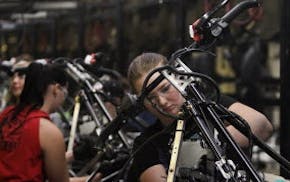Shuttling between classrooms at Anne Sullivan school in Minneapolis, teacher James Kindle noticed that classroom teachers were stretched mightily to serve the wide range of abilities in a school with many immigrants.
A teacher might be showing one group of students how to measure the angles in a triangle, while other students in the same class were just learning that "triangle" is the word for a three-sided polygon.
Kindle did some research, talked to other teachers and together they went to school district officials. The result is a pair of "newcomer classrooms" and a concentrated effort to jump-start the adjustment of Somali students in American schools.
The timing is good for Sullivan and other schools receiving a surge of Somali refugees.
"This is a heroic effort on Sullivan's part," said Lynn Harper, a district K-8 multicultural specialist.
The newcomer program is aimed at Somalis, but the concept could be adapted to any immigrant group, she said.
Students new to the country are steered into a classroom with other newcomers, so they can learn things like "triangle" before heading into classes with other students.
The district is ramping up the effort even before knowing results. The school board last month approved an expansion from Sullivan's two classrooms to eight newcomer classrooms, split between Sullivan and Andersen United school. Together the two schools account for one of every six K-8 students in the district from a Somali-speaking family. The expanded program starts next fall.
The Sullivan experiment comes as the school district sees an influx of students from Somalia. At the start of this year's classes, 336 refugee students had registered recently enough that they could have been eligible for newcomer classes. That's a marked increase over previous years.
To qualify, students must be in their first year in the United States, have parent approval, and test low on an assessment of their listening, speaking, reading and writing skills. Third through eighth-grade students anywhere in the city are eligible. They are expected to enroll in mainstream classes in their home schools after a year of catch-up at Sullivan or Andersen.
New challenge for teachers
For Kindle, who handles grades two through five, and colleague Stephany Jallo, who teaches middle-schoolers, their work in adjoining classrooms represents a new challenge.
Kindle has his own classroom for the first time in five years; previously he helped students learning English in classrooms run by other teachers.
He can draw on the experience of Jallo, a 10-year teacher who moved to Minneapolis from Richfield and also is licensed to teach English learners. She has experience with newcomers in a mixed class, but now she's leading a class with a steeper learning curve.
Their classrooms mix techniques. Some are as basic as reciting English phrases after the teacher. Some involve online lessons. Kindle posts photos of Somali-born figures such as Olympic track champion Mo Farah, weaves Somali folk tales into lessons and drops the occasional Somali phrase learned this fall in an evening Somali class requested by Sullivan teachers.
Mariam Adam, a Somali language specialist teacher at Sullivan, said she was astounded at how far Kindle and Jallo went to make their classrooms welcoming for students whose lives had been disrupted by refugee camps and migration. The loyalty flows both ways.
"When we tell them there's a holiday and no school Monday, there's almost like a mutiny," she said.
Students like Hamsa Muhamud, 10, feel like they're learning faster than they did in school in Ethiopia, where he lived until August. He walked to school and wore a uniform there, and could be kicked out if the uniform wasn't clean. He likes science and wants to teach it some day.
"My teachers are teaching me right now so I want to teach other people," he said. That's an ambition shared by classmate Mohamud Sugule, 11, who finds the curriculum broader than in Ethiopia and wants to teach math.
Signs of progress
The district's newcomer program is known as NABAD, which is both an acronym for its purpose and a Somali word that's used both to mean peace and as a greeting response. Expanding NABAD even before a year's data is in represents a leap of faith by the district. But the school sees signs of progress, even without the standardized testing that the outside world often judges results by. One sign is reading levels. In the first three months of NABAD, eight middle-schoolers started near the bottom of a widely used reading scale and then grew by at least three reading levels, with two rising from a pre-K level to first-grade entry level.
The expansion also meets a need. Sullivan alone has 62 students who tested as eligible for the newcomer program, far more than its current 40 spots. More are expected to apply next year when the program goes citywide.
What's good for Somali students is also good for Sullivan. Principal Ron Wagner has built the school's enrollment from 500 students to about 800 through five years of making connections with Somali immigrants, newcomers or not.
He knows he's succeeding in part because of the word-of-mouth at one downtown homeless shelter used by many newcomer families. The word is: Ask for Sullivan.
Steve Brandt • 612-673-4438 Twitter: @brandtstrib

Minnesota added thousands of jobs in March but worker shortage still an issue
Private prison van driver, accused of raping St. Paul woman he was transporting, gets 30 years for similar attacks

Shop the curbs for free on 'Trash to Treasure Day' in White Bear Lake
Longtime Uptown boutique closing in May

